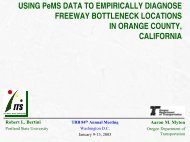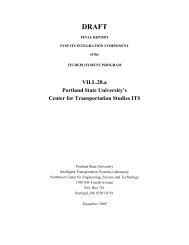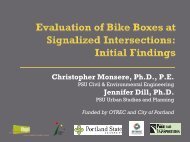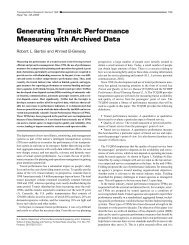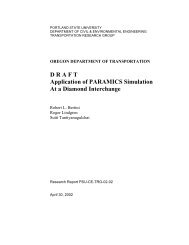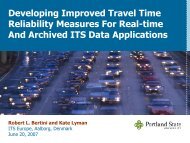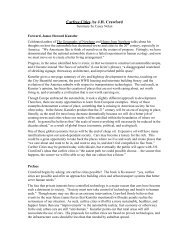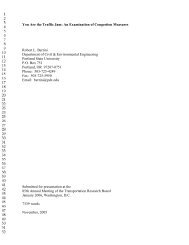D R A F T Application of PARAMICS Simulation At a Diamond ...
D R A F T Application of PARAMICS Simulation At a Diamond ...
D R A F T Application of PARAMICS Simulation At a Diamond ...
Create successful ePaper yourself
Turn your PDF publications into a flip-book with our unique Google optimized e-Paper software.
<strong>Application</strong> <strong>of</strong> <strong>PARAMICS</strong> <strong>Simulation</strong> at a <strong>Diamond</strong> Interchange Page 1<br />
INTRODUCTION<br />
Computer processing advances have led to the increased use <strong>of</strong> traffic simulation models.<br />
Depending on the simulation objectives, models range from macroscopic models that use<br />
traffic descriptors such as flow, density and speed to microscopic models, which detail the<br />
movement <strong>of</strong> individual vehicles. (1) Macroscopic models are generally applied over large<br />
geographical areas and are more useful for transportation planning and corridor operations<br />
analysis rather than detailed traffic engineering in areas with complicated geometry and tight<br />
right-<strong>of</strong>-way restrictions. Because <strong>of</strong> the level <strong>of</strong> detail required in a microscopic model,<br />
applications tend towards traffic operations over relatively small geographical areas.<br />
The Transportation Research Board’s Highway Capacity Manual (HCM) presents<br />
methodologies recommended for use in planning and operational analysis <strong>of</strong> an individual<br />
transportation network element such as a signalized intersection or a mainline section <strong>of</strong> a<br />
freeway. (1) The HCM equations and worksheets are based on limited statistical models that<br />
can be considered to be macroscopic. In part because the HCM models do not consider the<br />
behavior <strong>of</strong> individual vehicles, and due to the deterministic nature <strong>of</strong> HCM models, there is<br />
a growing recognition that stochastic microscopic simulation models can be very useful in<br />
operational analyses on small to mid-sized transportation networks. HCM 2000 includes<br />
Chapter 31 titled “<strong>Simulation</strong> and Other Models,” (1) which summarizes a number <strong>of</strong><br />
strengths and shortcomings <strong>of</strong> simulation models, as shown in Table 1.<br />
Table 1 <strong>Simulation</strong> Models<br />
<strong>Simulation</strong> Modeling Strengths<br />
• Can vary demand over time and space<br />
• Can model unusual arrival and service patterns that do not follow more traditional mathematical<br />
distributions Can experiment <strong>of</strong>f-line without using on-line trial-and-error approach<br />
• Other analytical approaches may not be appropriate<br />
• Can experiment with new situations that do not exist today<br />
• Can provide time and space sequence information as well as means and variances<br />
• Can study system in real time, compressed time, or expanded time<br />
• Can conduct potentially unsafe experiments without risk to system users<br />
• Can replicate base conditions for equitable comparison <strong>of</strong> improvement alternatives<br />
• Can study the effects <strong>of</strong> changes on the operation <strong>of</strong> a system<br />
• Can handle interacting queuing processes<br />
• Can transfer un-served queued traffic from one time period to the next<br />
<strong>Simulation</strong> Modeling Shortcomings<br />
• There may be easier ways to solve the problem<br />
• <strong>Simulation</strong> models may require verification, calibration, and validation, which, if overlooked, make such<br />
models useless or not dependable<br />
• Development <strong>of</strong> simulation models requires knowledge in a variety <strong>of</strong> disciplines, including traffic flow<br />
theory, computer programming and operation, probability, decision making, and statistical analysis<br />
• The simulation model may be difficult for analysts to use because <strong>of</strong> lack <strong>of</strong> documentation or need for<br />
unique computer facilities<br />
• Some users may apply simulation models and not understand what they represent<br />
• Some users may apply simulation models and not know or appreciate model limitations and assumptions<br />
• <strong>Simulation</strong> models require considerable input characteristics and data, which may be difficult or<br />
impossible to obtain<br />
• Results may vary slightly each time a model is run<br />
Portland State University Transportation Research Group 2002



